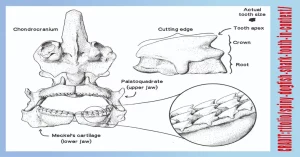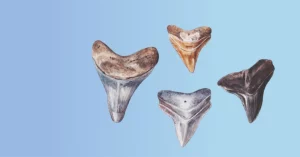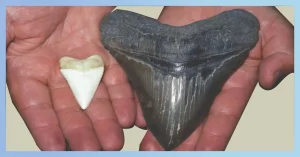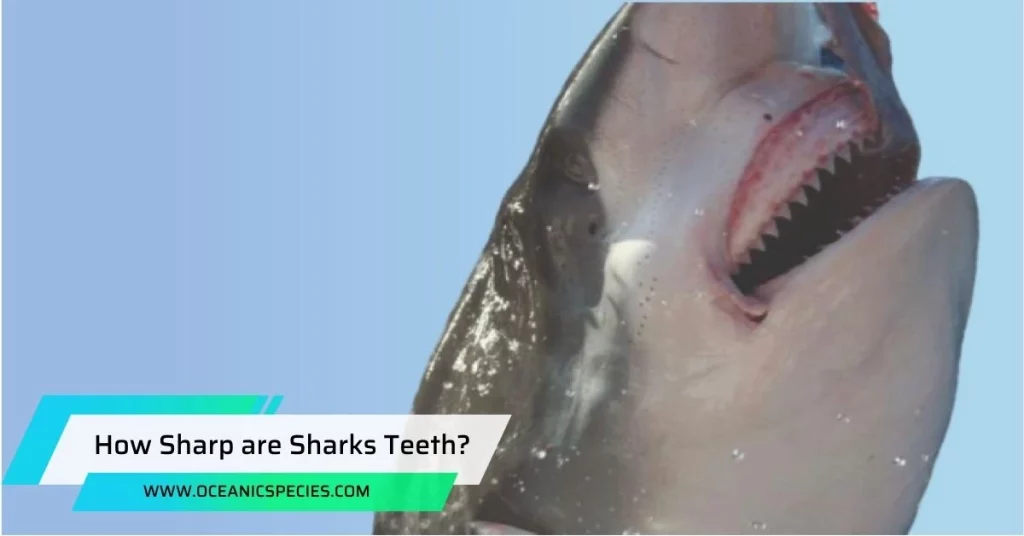Sharks’ teeth are extremely sharp and can vary in sharpness depending on the species and function. In addition to their sharpness, shark teeth are also designed to be effective tools for capturing and consuming prey.
These teeth are not only impressive in their appearance but also play a crucial role in the shark’s survival and success as a top predator.
We will explore the sharpness of shark teeth and how they enable these marine predators to thrive in their respective habitats. So, let’s dive into the world of shark teeth and uncover their razor-like sharpness.
The Anatomy Of A Shark’S Tooth
Understanding the structure and types of shark teeth gives us insight into how these incredible creatures have evolved to be such efficient hunters in the ocean.

With their razor-sharp teeth, sharks reign as some of the most fearsome predators in the sea.
The Structure Of A Shark’S Tooth
Sharks are fascinating creatures, known for their sharp teeth that strike fear into the hearts of many. But have you ever wondered about the anatomy of a shark’s tooth? Let’s take a closer look at the structure of these remarkable teeth that make them perfect predators in the ocean.
- Shark teeth are not fixed in their jaws like our teeth. Instead, they are constantly being replaced throughout the shark’s lifetime. As old teeth fall out, new ones grow in their place, ensuring that the shark always has a fresh set of pearly whites.
- The structure of a shark’s tooth is designed for maximum efficiency in capturing and consuming prey. Unlike human teeth, which are straight and flat, shark teeth are curved and serrated, resembling tiny saw blades. This shape allows them to be more effective in tearing through flesh and gripping onto slippery prey.
- The outer layer of a shark’s tooth is made up of hard enamel, which is one of the toughest substances in the animal kingdom. This enamel coating protects the tooth from wear and tear, ensuring its sharpness remains intact.
- Beneath the enamel layer is dentin, a dense tissue that gives the tooth its strength. Dentin makes up the majority of the tooth’s structure, providing support and durability.
- At the center of a shark’s tooth is the pulp cavity, which contains nerves and blood vessels. Although sharks do not experience toothaches like we do, the pulp cavity serves an important role in nourishing the tooth.
Types Of Shark Teeth
Did you know that not all shark teeth are the same? There are various types of shark teeth, each suited for different tasks. Here are some common types you might come across:

- Serrated teeth: These teeth have jagged edges and are ideal for tearing apart large prey. Sharks that mainly feed on fish, like the great white shark, have serrated teeth that allow them to grip onto slippery prey.
- Pointed teeth: Some sharks, such as the tiger shark, have pointed teeth that are perfect for piercing through tough shells and exoskeletons. These teeth help them prey on creatures like turtles and crustaceans.
- Flat and plate-like teeth: Sharks that feed on small organisms like plankton often have specialized teeth designed for filter-feeding. These teeth are flat and plate-like, forming a sieve that allows the shark to filter out tiny prey from the water.
- Multiple rows of teeth: Many sharks have multiple rows of teeth, with new teeth constantly growing in to replace old ones. This ensures that they always have a fresh supply of teeth, ready to go.
Specialized Teeth For Different Diets
Just as humans have different diets, sharks also have specialized teeth depending on their preferred prey. Let’s explore some examples:
- Carnivorous sharks: Sharks that primarily feed on other fish have sharp, pointed teeth that enable them to catch and grip their prey. These teeth are often curved and serrated, making them highly effective in tearing through flesh.
- Piscivorous sharks: Sharks that have a diet mainly consisting of fish have teeth designed for capturing and swallowing their slippery prey. Their teeth are needle-like and curved, allowing them to catch fish and prevent them from wriggling away.
- Shellfish predators: Sharks that feed on hard-shelled creatures like clams and crabs have strong, flat teeth that can easily crack open shells. These teeth are often flattened and broad, providing the necessary strength for breaking through tough exoskeletons.
- Filter feeders: Some sharks, like whale shark, have specialized teeth for filter-feeding. Their teeth are small, non-functional, and arranged in a sieve-like pattern. These teeth help them filter out tiny plankton from the water as they swim.
The Science Behind Shark Teeth Sharpness
Shark teeth are truly impressive structures with a remarkable combination of strength, hardness, and adaptability. The composition of dentin and enamel, along with the specialized adaptations for efficient feeding, contribute to the teeth’s sharpness and effectiveness in hunting.
Understanding The Composition Of Shark Teeth
Shark teeth are primarily composed of dentin and enamel, two hard substances that contribute to their strength and sharpness.

Dentin, a calcified tissue, forms the bulk of a shark tooth. It is responsible for providing structural support and durability. Enamel, the outermost layer of the tooth, is the hardest tissue in the animal kingdom. It protects the tooth from wear and tear and plays a crucial role in enhancing its sharpness. The combination of dentin’s strength and enamel’s hardness gives shark teeth their exceptional cutting ability, allowing them to slice through flesh and tear apart prey.
The Role Of Dentin And Enamel
Dentin serves as the foundation of shark teeth, providing a sturdy framework that maintains the tooth’s shape and structure. Enamel, with its incredibly hard composition, adds an extra layer of protection and sharpness to the tooth, enabling it to puncture and penetrate prey with ease. The arrangement of dentin and enamel in the tooth is strategically designed to enhance the overall efficiency and cutting power of the tooth.
Adaptations For Efficient Feeding
Shark teeth are not only sharp but also replaceable. Unlike human teeth, which are fixed, shark teeth continuously grow and can be replaced throughout their lifetime. The continuous replacement of teeth ensures that sharks always have a fresh set of sharp teeth available for hunting. Different shark species have teeth with various shapes and sizes, each adapted to their preferred prey. Some species have razor-sharp teeth for slicing through fish, while others have robust teeth for crushing shells or tearing apart prey.
Sharks also have specialized teeth in different areas of their jaws, such as sharp teeth at the front for capturing prey and flat teeth at the back for crushing and grinding food. These adaptations allow sharks to efficiently capture, consume, and process their food, making them highly successful hunters in the ocean ecosystem.
Unleashing The Power Of Shark Teeth
Shark teeth truly are extraordinary adaptations that showcase the power and prowess of these majestic creatures. Through vibrant hunting techniques, teeth aid in prey capture, and evolutionary advantages, sharks have carved out their place as some of the most formidable predators in the oceans.
Let’s dive deeper and explore the incredible power of shark teeth.
The Hunting Techniques Of Sharks
Sharks employ various hunting techniques, depending on their species and habitat. Here are some key points to consider:
- Ambush predators: Some sharks, like the great white, are masters of stealthy ambushes. They patiently wait for their prey, such as seals, to come close before launching a swift attack.
- Pursuit predators: Other shark species, such as the mako shark, are built for speed. They chase down their prey, using their streamlined bodies and powerful tails to their advantage.
- Cooperative hunting: Certain social shark species, like the grey reef shark, display cooperative hunting behaviors. They work together to corral their prey into a vulnerable position before launching an attack.
How Teeth Aid In Prey Capture
Shark teeth are essential tools for capturing and consuming prey efficiently. Consider the following:
- Multiple rows of teeth: Sharks have multiple rows of teeth that are continually replaced throughout their lives. This ensures they always have sharp and functional teeth in case one breaks or wears down.
- Shape and design: Shark teeth come in a variety of shapes and sizes, each suited to their specific dietary needs. For instance, the teeth of a white shark are serrated and triangular, perfect for gripping and tearing through tough flesh and bone.
- Voracious appetite: Sharks are known for their voracious appetite, and their teeth enable them to consume large quantities of prey swiftly. The teeth act as powerful cutting and gripping tools, aiding in the tearing and dismemberment of prey.
Evolutionary Advantages Of Sharp Teeth
Shark teeth have evolved over millions of years, providing distinct advantages to these formidable creatures. Consider the following evolutionary highlights:
- Adapted to diet: The shape, size, and arrangement of shark teeth are directly linked to their specific diets. This adaptability allows sharks to exploit a wide range of ecological niches effectively.
- Efficient feeding: With sharp teeth, sharks can efficiently consume their prey, reducing energy expenditure during feeding. This advantage allows them to maximize their nutrient intake and overall fitness.
- Competitive advantage: Shark teeth give them a competitive edge over other predators in their environment. Their formidable dentition enables them to capture and secure prey that might be inaccessible to other species.
Frequently Asked Questions
Do All Sharks Have Sharp Teeth?
Yes, all sharks have sharp teeth as they are designed to tear and shred their prey.
How Do Sharks Use Their Teeth?
Sharks use their teeth to catch and hold onto prey, as well as to rip and tear flesh for feeding.
Can Shark Teeth Cut Through Bone?
Yes, some larger species of sharks have teeth that are strong enough to cut through bone.
Are Shark Teeth Stronger Than Human Teeth?
Yes, shark teeth are stronger and more durable than human teeth, designed for hunting and consuming prey.
Conclusion
To sum up, sharks possess remarkable teeth that serve various functions in their daily lives. Their teeth are incredibly sharp and well-adapted to their carnivorous diet, enabling them to tear through flesh with ease. The shape and arrangement of the teeth differ depending on the species and their feeding habits.
From the razor-sharp, pointy teeth of great white sharks to the multiple rows of serrated, dagger-like teeth in tiger sharks, each type of tooth is perfectly designed for its specific purpose. These teeth allow sharks to hunt efficiently and remain at the top of the marine food chain.
Additionally, their ability to continuously replace lost or damaged teeth throughout their lives ensures they always have a formidable set of chompers.





